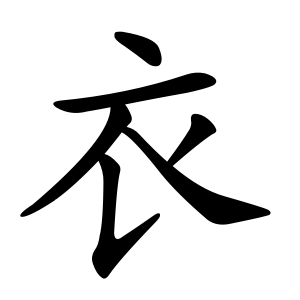衣
- clothes, clothing;
- garment;
It signifies "clothes," "apparel (衣服)," and the action "to wear."
Etymology
It is a pictogram representing a garment worn with a collar fastened.
Historically, upper body clothing was represented by 衣 (clothes) and lower body clothing by 裳 (skirt), together called 衣裳 (clothing or costume). The reading for 衣 as "clothes" was already established in Middle Korean, although the final consonant sound was somewhat different.
Usage in Korean
The character 衣 is mainly related to clothing. When used as a radical, it appears in three main forms:
1. As the “clothes” radical 衤 on the side (usually the left side of a character).
Examples of characters using this form include:
複 (to double),
褐 (brown),
補 (to mend),
裸 (naked),
被 (to wear).
2. In its full form 衣, combining directly with other components.
Examples include:
裳 (skirt),
裂 (to tear),
裝 (to decorate),
製 (to make).
3. Split into two parts—usually the top and bottom—surrounding another component, somewhat like 行 (to go).
Examples include:
表 (surface),
衰 (to decline),
衷 (heartfelt),
襄 (to help).
For instance, the character for “inside” can be written two ways: 裡 (with the radical 衤 on the left side, form 1) and 裏 (with the split 衣 form, form 3). Both are used depending on context.
Alternative forms
Characters with 衣
Words that derived from 衣
- 卜竹女 (YHV)
- ⿱ 亠 𧘇
